
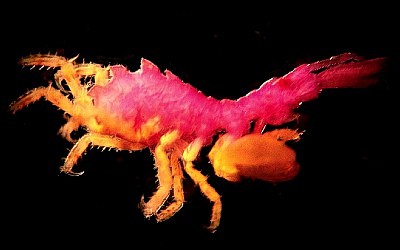
Flabellina iodinea
(Cooper, 1862)
Order: NUDIBRANCHIA
Suborder: AEOLIDINA
Family: Flabellinidae
DISTRIBUTION
Galapagos Islands to British Columbia, Canada.
PHOTO
UPPER: Santa Barbara County, California, subtidal. Photo: Todd Huspeni.
LOWER: amphipod crustacean mimic Podocerus cristatus, Diablo Canyon, San Luis Obispo County, central California. Photo: Mike Behrens.
Flabellina iodinea is one of the most visually stunning and common aeolids in southern and central California. It has been reported from off of Punta Asuncion, Baja California Sur, Mexico (Mulliner, 1982) to Vancouver Island, British Columbia, Canada (Bernard, 1970), but is rare north of San Francisco and has never been collected from the outer coast of Oregon and Washington. Flabellina iodinea has also been found at sites scattered throughout the Gulf of California, especially in deeper or colder waters (Bertsch & Kerstitch, 1984) and in the Galapagos Islands (Gosliner, 1991). It has the common name "Spanish Shawl".
Flabellina iodinea preys selectively on the orange polyps of the athecate hydroid Eudendrium ramosum (Engel, 1976; McDonald & Nybakken, 1978; personal observations). McBeth (1972) showed that the purple pigment in the body of F. iodinea, the orange color in its cerata, and the scarlet red in its rhinophores are all derived from a single carotenoid pigment, astaxanthin, obtained from its hydroid prey. In the aeolid, this pigment occurs in three slightly different states (free, esterified, and conjugated with a protein), resulting in the three distinct colors.
In central California, Gosliner & Behrens, (1990) reported a color variety of the amphipod crustacean Podocerus cristatus mimicking Flabellina iodinea. Another color variety of this same amphipod mimics F. trilineata on the central Oregon coast.
Flabellina iodinea lays bright pinkish orange colored egg ribbons, usually on the stalks of its hydroid prey. The eggs develop into planktotrophic veligers after 7 days at 14deg C (Engel, 1976; personal observations). When disturbed by potential predators such as seastars, Flabellina iodinea can lift off the substratum and swim away by flexing its body strongly and gracefully from side to side. (MacFarland, 1966; Farmer, 1970; personal observations). It grows to approx 70mm, and is found from the intertidal to approx. 40m deep.
References:
• Bernard, F. R. (1970) A distributional checklist of the marine molluscs of British Columbia: based on faunistic surveys since 1950. Syesis, 3:75-94.
• Bertsch, H. & A. Kerstitch. (1984) Distribution and radular morphology of various nudibranchs (Gastropoda: Opisthobranchia) from the Gulf of California, Mexico. The Veliger, 26: 264-273.
• Engel, C. P. (1976) The biology and life history of the nudibranch Flabellinopsis iodinea (Cooper, 1863). Ph.D. Dissertation, University of California, Santa Barbara, California.
• Farmer, W. M. 1970. Swimming gastropods (Opisthobranchia and Prosobranchia). The Veliger, 13: 73-89.
• Gosliner, T. M. 1991. The opisthobranch gastropod fauna of the Galapagos Islands. Pp. 281-305 [in] M. J. James (ed.), Galapagos marine invertebrates: taxonomy, biogeography, and evolution in Darwin's islands. Plenum Press: New York.
• Gosliner, T.M. & D.W. Behrens. (1990) Special resemblance, aposematic coloration, and mimicry in opisthobranch gastropods. Pp. 127-138 [In] M. Wicksten (ed.) Adaptive coloration in invertebrates. Texas A & M University Sea Grant Program: College Station, Texas, USA.
• McBeth, J. W. 1972. Carotenoids from nudibranchs. Comparative Biochemistry and Physiology, 41(B): 55-68.
• MacFarland, F. M. 1966. Studies of opisthobranchiate mollusks of the Pacific coast of North America. Memoirs of the California Academy of Sciences, 6: 1-546.
• McDonald, G.R. & J.W. Nybakken. (1978) Additional notes on the food of some California nudibranchs with a summary of known food habits of California species. The Veliger, 21(1):
110-119.
• Mulliner, D. (1982) Personal notes, from Dave Mulliner. Opisthobranch Newsletter, 14: 2.
Goddard, J.H.R., 2000 (July 1) Flabellina iodinea (Cooper, 1862). [In] Sea Slug Forum. Australian Museum, Sydney. Available from http://www.seaslugforum.net/find/flabiodi
Related messages
Re: Flabellina iodinea mating
August 19, 2009
From: Jonathan S. Klenk

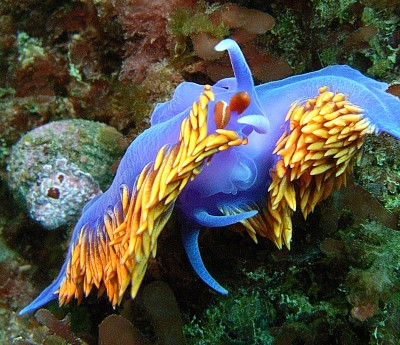
Concerning message #14779:
These pictures of Flabellina iodinea (Spanish Shawl Nudibranch) mating were taken in march 2007 at Catalina Island off the coast of Southern California. I have a whole series of the mating behaviour, including where their genitals start protruding from their right-sides.
The first picture is just prior to mating. The second is where they are mating, and the third is post mating, where you can still see the sperm remaining in the vaginal opening of the Nudibranch on the right.
Locality: Catalina Island, 25 ft, So. California, USA, Pacific Ocean, 21 March 2007, Intertidal. Length: approx. 1 inch. Photographer: Jonathan S. Klenk.
Jonathan S. Klenk.
JKlenk@Scuba-Instr.com
Klenk, J.S., 2009 (Aug 19) Re: Flabellina iodinea mating. [Message in] Sea Slug Forum. Australian Museum, Sydney. Available from http://www.seaslugforum.net/find/22562
Dear Jonathan,
Thanks for this nice series of photos
Best wishes,
Bill Rudman
Re: Flabellina iodinea feeding
May 16, 2007
From: Roger Carlson
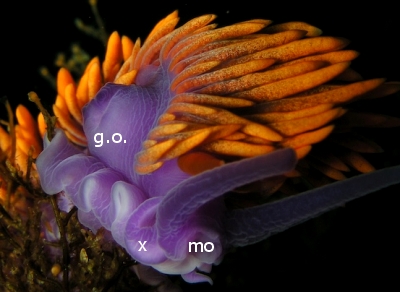
Concerning message #19353:
Hi Bill,
Jim sent me a link to this page and suggested I send in some more photos. Not all of these images show the branch feeding, but they do show the complexity of the undercarriage and may help you see what's involved in feeding.
Locality: Redondo Beach, 80 feet, CA, Pacific Ocean, Various dates., Rocky reef, kelp forest, steel wreck. Length: 3 inches. Photographer: Roger Carlson.
Roger Carlson
Roger@laups.org

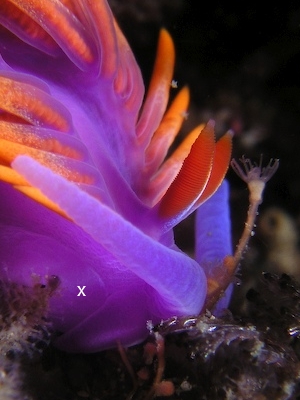
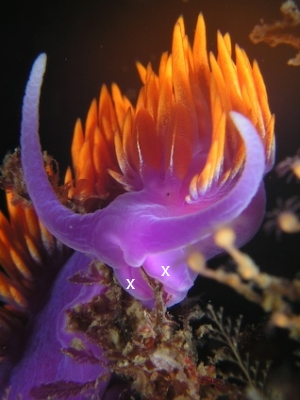
Dear Roger,
Thanks for these photos. I have labelled some of the major parts including the genital opening [g.o.], mouth [mo] anf the strange secondary tentacles [x] I commented on in Jim's message. I guess they are part of the foot, but I have never seen anterior foot corners separated from the foot like this and so obviously involved with handling the food.
Best wishes,
Bill Rudman
Flabellina iodinea from Bahia California
May 16, 2007
From: Natasja Vandeperre
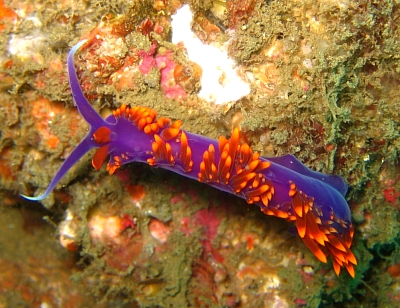

Hello Bill,
I send you a few pictures of a giant(!!!) Flabellina iodinea. According to Debelius it's maximum length is 40 mm???? I believe this one was between 100 and 150 mm. When you compare it with the stuff on the background, you will see how big it is.
Locality: La Paz, La Reinita, 36 m, Mexico, Baia California, Sea of Cortez, 10 July 2006, Reefwall. Length: 100 - 150. Photographer: Natasja Vandeperre
Natasja Vandeperre
(Belgium)
.
nvandeperre@pandora.be
Vandeperre, N., 2007 (May 16) Flabellina iodinea from Bahia California. [Message in] Sea Slug Forum. Australian Museum, Sydney. Available from http://www.seaslugforum.net/find/19129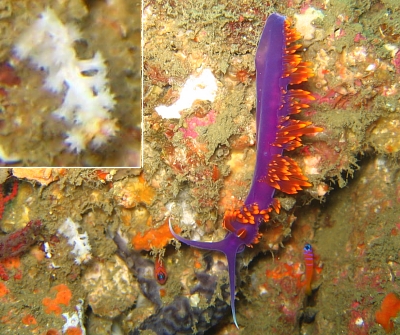
Dear Natasja,
On the Forum we have it as growing to 70 mm long and Behrens & Hermisillo have it growing to at least 60 mm, so Debelius is probably a bit under in his estimation. While looking in the background I found a nice little white Hancockia californica.
Best wishes,
Bill Rudman
Flabellina iodinea feeding
February 2, 2007
From: James Lyle
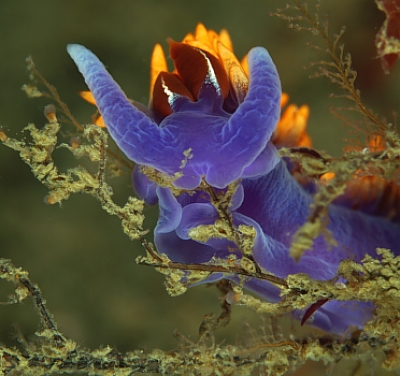

Dr. Rudman,
The colorful "Spanish Shawl" nudibranch (Flabellina iodinea) is common in Southern California waters and the Forum has a nice set of images of these branchs, but I did not see any showing feeding behavior. One of the attached images clearly shows the branch munching on its favorite food, Eudendrium. The other two images are close ups of the head, one showing the eye spot and the other the mouth parts.
Locality: Redondo Beach, 20 meters, California, USA, Pacific Ocean, 28 February 2007, wreck. Length: 2.5 cm. Photographer: Jim Lyle.
Jim Lyle
jlyle@adelphia.net
Lyle, J.L., 2007 (Feb 2) Flabellina iodinea feeding. [Message in] Sea Slug Forum. Australian Museum, Sydney. Available from http://www.seaslugforum.net/find/19353
Thanks Jim,
The colour of this species is quite spectacular. I guess I have seen illustrations of the anterior foot before, but your photos of the head suggest that the large tentacular processes on each side of the mouth seem to originate from the head rather than the foot. Quite a few aeolids have the anterior corners of the foot extended out as tentacles to varying degrees, culminating in species which are said to have 'tentacular foot corners'. In all those cases the 'foot corners' are clearly part of the foot. In your photos, they seem to be quite separate from the foot. It would be interesting to know what they do during feeding. I can't see what they are doing in your photo. Are they involved in feeding?
Best wishes,
Bill Rudman
Re: Flabellina iodinea mating
September 17, 2005
From: James Lyle

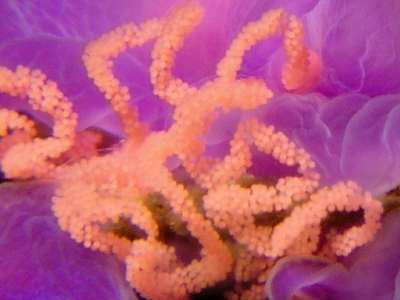
Dr. Rudman,
In response to your question about Flabellina iodinea staying in one place [message #14767 ]:
The animals move around a lot, feeding on hydroids, but in this location, there are many, many individuals - I would estimate 20 - 30 per square metre. Yes, those are F. iodinea eggs.
I'm attaching a recent image of a branch I caught in the act of depositing the future generation.
Locality: Wreck of the Avalon, Palos Verdes peninsula, California, USA
Depth: 25 metres, Length: 20 mm. 10 September 2005. ship wreck. Photographer: Jim Lyle
Best,
Jim
jlyle@scubadiving.com
Lyle, J.L., 2005 (Sep 17) Re: Flabellina iodinea mating. [Message in] Sea Slug Forum. Australian Museum, Sydney. Available from http://www.seaslugforum.net/find/14779Thanks Jim,
I didn't realise they could be so common.
Best wishes,
Bill Rudman
Re: Flabellina iodinea mating
September 15, 2005
From: James Lyle

Dr. Rudman,
In an older message you mention that you don't have an image of Flabellina iodinea mating. Here's one for your files.
Locality: Palos Verdes Peninsula, California, USA. Depth: 25 metres. Length: 25 mm.12 December 2004. rocky reef. Photographer: Jim Lyle
Best,
Jim Lyle
jlyle@scubadiving.com
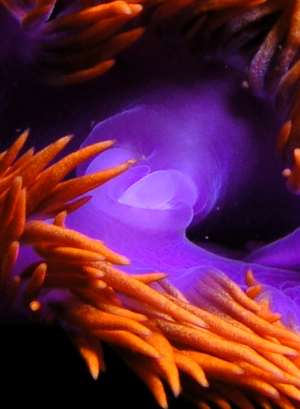
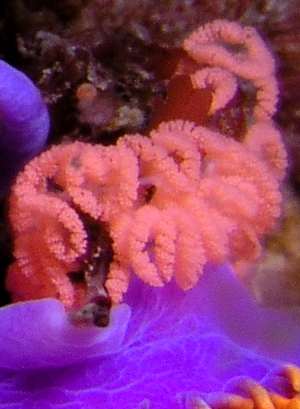
Thanks Jim,
It's interesting to see a pair mating like this right alongside what I am pretty sure is one of their egg ribbons. Are they one of those species which tends to stay in the same place for some time?
Best wishes,
Bill Rudman
Flabellina iodinea laying eggs
September 23, 2003
From: Chris Menjou

Here's a pic of Flabellina iodinea [a Spanish Shawl] laying eggs at Landing Cove, Anacapa Island, Channel Islands [California, USA] in July 2003. Depth was approx. 30 feet.
Chris Menjou
cjmenjou@hotmail.com
Menjou, C., 2003 (Sep 23) Flabellina iodinea laying eggs. [Message in] Sea Slug Forum. Australian Museum, Sydney. Available from http://www.seaslugforum.net/find/10983Thanks Chris,
Bill Rudman
Flabellina iodinea feeding on hydroids
August 5, 2003
From: Bruce Wight
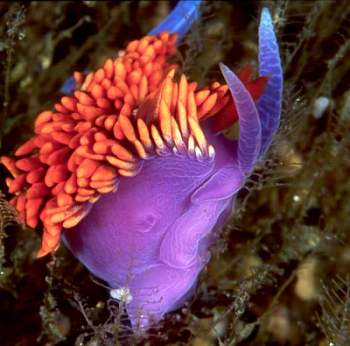
Dear Bill,
Johanna and I saw lots of great natural behavior on last weekends dive trip out to San Miguel Island [Channel Islands National Park, California - July 2003]. Here is one of a series of messages showing some images I took during the two day trip.
This photo is of Flabellina iodinea feeding on hydroids.
Best wishes,
Bruce Wight
bwproductions@earthlink.net
Wight, B., 2003 (Aug 5) Flabellina iodinea feeding on hydroids. [Message in] Sea Slug Forum. Australian Museum, Sydney. Available from http://www.seaslugforum.net/find/10650Thanks Bruce,
Bill Rudman
Flabellina iodinea from California
July 31, 2003
From: Chris Grossman
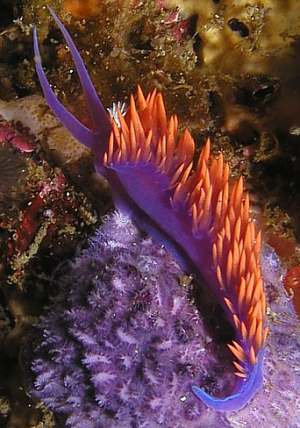
Dear Bill
I took this photo on the North side of Sutil Island at Santa Barbara Island, California, 19 July, 2003. The 'Spanish Shawl' (Flabellina iodinea) is very common there but I though this picture of it on encrusting hydrocoral is nice.
Chris Grossman
seaslugforum.net@diver.net
Grossman, C., 2003 (Jul 31) Flabellina iodinea from California. [Message in] Sea Slug Forum. Australian Museum, Sydney. Available from http://www.seaslugforum.net/find/10609Thanks Chris,
Bill Rudman
Flabellina iodinea mating
March 22, 2003
From: Gaby Chavez
I am doing a project that is due Friday and I have all the information I need so far but im having a little trouble finding facts about Flabellina iodinea. I already have things about the ceras being blood tubes and holders of digestive glands. Also, I got info on how it lays eggs ... but what i was more interested in finding, if possible, was how they mated. If you could help, this would be greatly appreciated. Sorry about the late notice.
Thank you,
Gaby
froggc@comcast.net
Dear Gaby,
I don't usually have the time, or the inclination, to do rush jobs for class projects, but since it isn't a 'tell me everything about Flabellina iodinea - and I want it immediately' request, here goes:
I guess you have had a look at the Flabellina iodinea Fact Sheet and the messages attached to it. As you will see there, all nudibranchs are hermaphrodite and so have fully functional male and female reproductive systems. When mating, they act as both male and females simultaneously. If you look carefully at the upper photo in Jeff Goddard's message you will see a darker swelling on the right side of the body near the head. This is the genital pore or reproductive opening. During mating, both the penis and the vagina are pushed out of this opening so they can make contact with the mating apparatus of their partner. I have haven't a photo of Flabellina mating but there is a good photo of another aeolid, Sakuraeolis enosimensis, mating which is very similar.
Good luck with your assignment
Bill Rudman
Spanish Shawl Nudibranch
February 6, 2003
From: Chase Walden
Hi!! My name is Chase Walden. I am in the fifth grade. I am having some trouble finding information on a Spanish Shawl Nudibranch. I need to know the size of it.
I need to find some information sources. Is this sea creature rare?
THANK'S
Chase Walden
jray210@charter.net
Dear Chase,
Have a look at the Fact Sheet for that species, and if you have a look at the other messages on this page you will find quite a lot more information on it. Its scientific name is Flabellina iodinea, and it is an aeolid nudibranch. Aeolids have some interesting ways of defending themselves. Have a look at the pages on cerata and cnidosacs for some background information.
Best wishes,
Bill Rudman
Spanish Shawl Dancer
November 20, 2001
From: Anna
Dear Gentlemen,
I am a 5th grade elementary student in Oxford, CT. [USA] My class is studying sea creatures. I saw a picture in my class of a nudibranch which appeared to be purple color w/red and yellow spines on its' back. I believe that this creature lives in the Pacific Ocean. I have tried searching Encyclopdias but am having no success. I would like to learn about the Spanish Shawl Dancer's eating and mating habits and Would greatly appreciate and any pictures you might have. Thank you for taking the time to read my request. Also, thank you for any help or advice you could give me.
Anna
shields1ps@aol.com
Anna, 2001 (Nov 20) Spanish Shawl Dancer. [Message in] Sea Slug Forum. Australian Museum, Sydney. Available from http://www.seaslugforum.net/find/5703Dear Anna,
The animal you are interested in is Flabellina iodinea. Have a look at the top of this page for some photos of it and some information on its biology. You'll see there that it found in the eastern Pacific from the Galapagos Ids to Canada, and gets it bright colours from the hydroids it feeds on. Also have a look at the other messages below yours on this page, because there are more photos and information there. The yellow 'spikes' on its back are called cerata. Have a look at the Cerata Page for more information on these fascinating structures. When you are using the Forum, click on any underlined word and you will be taken to another relevant page.
Good Luck with your project,
Bill Rudman
Reproduction in Flabellina iodinea
October 31, 2001
From: Jennifer
Hello,
I'm doing a report for school and I got kind of confused with all the big words websites use when explaining the reproductive cycle of the Flabellina iodinea. I got the impression that both sexes got pregnant. Is that true? And I never found out how long the fertilization is. Can you help me?
From,
Hopeless in Hodgdon
Jennifer
markwlunn@rcn.com
Jennifer, 2001 (Oct 31) Reproduction in Flabellina iodinea. [Message in] Sea Slug Forum. Australian Museum, Sydney. Available from http://www.seaslugforum.net/find/5578Dear Jennifer,
I don't know why you call yourself 'hopeless' - after all you did find the Sea Slug Forum! I didn't know there were any websites explaining the life cycle of Flabellina iodinea. I wouldn't mind a reference to the sites please. As far as I know the only reference is Engel's thesis (1976) which is listed at the top of the page. I guess you would have to go to Santa Barbara to look at it. All I know is that they lay eggs [see photos in Mike Miller's message] and the eggs take about a week to hatch as free-swimming veliger larvae which live in the plankton, feeding on phytoplankton (microscopic plants), before settling on to the sea bottom and turning into miniature slugs. I don't know how long they last in the plankton.
Now to the rest of your question. You ask if both sexes become pregnant. Firstly mammals are the only animals that really become pregnant, because 'being pregnant' basically means growing an embryo or carrying a baby inside your body. With few exceptions, only mammals do that. Some other animals become enlarged as large numbers of unfertilised eggs develop inside them. They may look pregnant but a better term for them is probably 'gravid'. However nudibranchs don't fit into either category. They are hermaphrodite which means they have a fully functioning set of male and female reproductive organs. This means they all produce eggs and sperm, and so can act as both male and females. The one thing we think they can't do is fertilise their own eggs.
I hope that answers your questions
Best wishes,
Bill Rudman
Flabellina iodinea laying eggs
August 6, 2001
From: Michael D. Miller

Dear Bill
Attached you will find an image of Flabellina iodinea with egg mass to complement Daniel Geiger's recent submission.
Photo taken at Wilson's Rock, San Miguel Island, Channel Islands, California at a depth of approx 70 ft (July, 2001).
Cheers;
Mike Miller
mdmiller@cts.com
Miller, M.D., 2001 (Aug 6) Flabellina iodinea laying eggs. [Message in] Sea Slug Forum. Australian Museum, Sydney. Available from http://www.seaslugforum.net/find/5005Thanks Mike,
Bill Rudman
Flabellina iodinea from California
August 3, 2001
From: Daniel Geiger
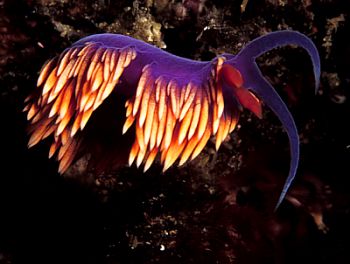
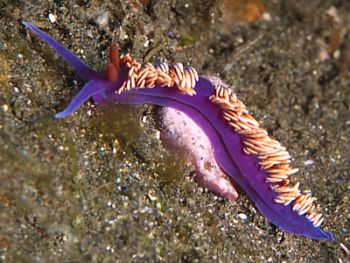
Dear Bill,
Here are some photos of Flabellina iodinea for the Forum. They were taken at West Anacapa Island, Channel Islands National Park, California, in 8-10 m, 5 July 2001. The animals were approx 2-3 cm long.
Best wishes,
Daniel Geiger
dgeiger@nhm.org
Geiger, D., 2001 (Aug 3) Flabellina iodinea from California. [Message in] Sea Slug Forum. Australian Museum, Sydney. Available from http://www.seaslugforum.net/find/4985Thanks Daniel,
I have oftened wondered why this animal was called the "Spanish Shawl", but your upper photo, of an animal with cerata hanging down, answers the question.
Best wishes,
Bill Rudman
Flabellina iodinea
April 20, 2001
From: Brett Maton
Hi,
I was wondering if you could add the common name of this species (Flabellina iodinea) which is known as a "Spanish Shawl" to most Californian scuba divers. Had great fun trying to track it down here :)
Brett
matonb@hotmail.com
Maton, B., 2001 (Apr 20) Flabellina iodinea. [Message in] Sea Slug Forum. Australian Museum, Sydney. Available from http://www.seaslugforum.net/find/4171Dear Brett,
Happy to add the common name 'Spanish Shawl'. Now that your message is on board the SEARCH button will find the page in future.
The reason I don't use common names is that they can be very confusing. Often they are not 'common' but are made up for colour photo books at the insistence of editors who think readers are dumb and won't understand scientific names. Another problem is that 'real' common names, that is names that are really in common use, are often used only in a small part of a species geographic range. And a third problem is that the same common name can be used for quite different species in different places. One of the reasons scientific names were 'invented' was to provide a single name for each species which could be used throughout the world.
Gardeners use scientific names for their plants all the time and often don't realise they are doing it, so I don't see why animal lovers think it's difficult. Using scientific names would solve a lot of problems.
Best wishes,
Bill Rudman
Flabellina iodinea and mimic
July 2, 2000
From: Jeff Goddard


Hi Bill,
Here is a photo by Todd Huspeni of a Flabellina iodinea collected subtidally in Santa Barbara County, California, USA, along with some information on this exquisite aeolid for The Forum.
I have also enclosed a photo by Mike Behrens (Dave's son) of the amphipod crustacean mimic of the aeolid. The amphipod was collected from Diablo Canyon, San Luis Obispo County, in central California.
This color variety of the amphipod crustacean Podocerus cristatus mimics Flabellina iodinea in central California (Gosliner & Behrens, 1990). Another color variety of this same amphipod mimics Flabellina trilineata on the central Oregon coast.
Reference: Gosliner, T.M. & D.W. Behrens. 1990. Special resemblance, aposematic coloration, and mimicry in opisthobranch gastropods. Pp. 127-138 [In] M. Wicksten (ed.) Adaptive coloration in invertebrates. Texas A & M University Sea Grant Program: College Station, Texas, USA.
Best wishes,
Jeff
Goddard@lifesci.ucsb.edu
Goddard, J., 2000 (Jul 2) Flabellina iodinea and mimic. [Message in] Sea Slug Forum. Australian Museum, Sydney. Available from http://www.seaslugforum.net/find/2641Dear Jeff,
I don't know why you Californians bother leaving home. You certainly have some of the most spectacularly coloured nudibranchs around! I have out most of your information on the species page. I had forgotten about F. iodinea getting its red/orange pigment from its food. A fascinating story.
Best wishes,
Bill Rudman.
